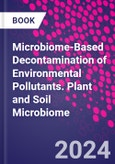Microbiome-Based Decontamination of Environmental Pollutants explores the complex interactions of plant-associated microbiomes, providing insights into the pressing challenges of managing environmental resources such as soil, water, and waste. Analysis has shown a formidable potential based in the network interactions between plant microbiota and environmental contaminants. This book presents insights into the potential exploitation of these plant-associated microbial functions. This volume in the Plant and Soil Microbiome series summarizes microbiological aspects of environmental management from the basics to advanced theoretical as well as practical aspects of microbial-based approaches. The physical and chemical changes caused by pollution of an ecosystem can occur rapidly, significantly impacting the functionality of ecosystem services in that environment. Environmental contamination poses and increasingly global challenge through direct and indirect adverse impacts on the climate, soil productivity and the health concerns of human beings. Traditional remediation techniques are not consistently feasible in mitigating environmental contaminants challenges in terms of cost-effectiveness, limited land resources and toxic residual products. The use of plant-associated microbes as part of a network of tools opens a new door to explore an alternative, eco-friendly and economical technology to mitigate the challenges of environmental contamination.
Please Note: This is an On Demand product, delivery may take up to 11 working days after payment has been received.
Table of Contents
1. Bioremediation: using indigenous microorganisms to clean up the environment2. Significance, mechanisms and environmental implications of microbe mediated remediation
3. Microbiome immobilized sorbents: status and future aspects
4. Understanding and Designing the Strategies for the Microbe-Mediated Remediation of Environmental Contaminants Using Omics Approaches
5. Microbial Indicators for Monitoring Pollution and Bioremediation
6. Bioremediation of high molecular weight polycyclic aromatic hydrocarbons
7. Biochemical approach in microbial degradation organic contaminants
8. Microbial Bioremediation of Metal and radionuclides: Approaches and Advancement
9. Microbe assisted remediation of xenobiotics: A sustainable solution
10. Importance of microbial surfactants in heavy metal remediation
11. Role of Microbial biofilms in bioremediation: Current Perspectives
12. Applications of Microbial extracellular polysaccharides in Bioremediation
13. Exploring the potential of cyanobacteria in contamination management
14. Potential use of Endophytic microbe in environment contamination management
15. Environmental antibiotics and resistance genes as emerging contaminants: and their bioremediation
16. Synthetic Microbial Consortia: utilization in environment sustainability
17. Microbiological risk assessment of food OR genetically modified organisms
Authors
Ajay Kumar Amity Institute of Biotechnology.Dr. Ajay Kumar is currently working as an assistant professor at Amity Institute of Biotechnology, Amity University, Noida, India. Dr. Kumar recently completed his tenure as a visiting scientist from Agriculture Research Organization, Volcani Center, Israel. He has published more than 200 research, review articles, and book chapters in international and national journals. He serves as an associate editor for Frontiers in Microbiology, BMC Microbiology and as guest editor for various journals such as Plants, Microorganisms, and Sustainability. Dr. Kumar has also edited more than 40 books with the leading publishers such as Elsevier, Springer, and Wiley. Dr. Kumar's research experience is in the field of plant-microbe interactions, postharvest management, cyanobacterial biology, and so on
Joginder Singh Panwar Professor, Department of Botany, Nagaland University, Nagaland, India. Prof. Joginder Singh is a Professor in the Department of Botany at Nagaland University in India. Previously, he has worked as Young Scientist at Microbial Biotechnology and Biofertilizer Laboratory, Department of Botany, Jai Narain Vyas University in Department of Science and Technology, Govt. of India. He is an active member of various scientific societies and organizations including, Association of Microbiologists of India, Indian Society of Salinity Research Scientists, Indian Society for Radiation Biology, and European Federation of Biotechnology. He has published extensively, including both journal papers and book chapters. He serves as a reviewer for many prestigious journals, including Current Research in Engineering, Science and Technology, Journal of Cleaner Production, Science of the Total Environment, Environmental Monitoring and Assessment, Pedosphere, Soil and Sediment Contamination, Symbiosis, International Journal of Phytoremediation, Ecotoxicology and Environmental Safety, Annals of Agricultural Sciences, Annals of the Brazilian Academy of Sciences and many more. Lucas Carvalho Basilio de Azevedo Professor at the Institute of Agricultural Sciences, Federal University of Uberland, Brazil. Dr. Lucas C. B. Azevedo holds a degree in Agronomy (State University of Londrina, Brazil), MSc in Soil Science (Federal University of Lavras, Brazil), and PhD in Soil Science and Plant Nutrition (University of S�o Paulo, Brazil), which included an internship at Kansas State University, USA. He was named Assistant Professor at the Federal Institute of Goi�s State, Brazil teaching Soil and Environmental Microbiology classes. He was named Adjunct Professor at the Institute of Agricultural Sciences of the Federal University of Uberl�ndia and is currently Associate Professor teaching the subjects of Soil Microbiology, Bioremediation, and Introduction to Soil Science to undergraduate courses of Agronomy and Environmental Engineering. For graduate courses in Environmental Quality and Agronomy, he has taught Soil Ecology classes. As a researcher, he has studied and collaborated in investigations of soil quality indicators soil microbiology soil contamination and remediation and plant growth promoting microorganisms







